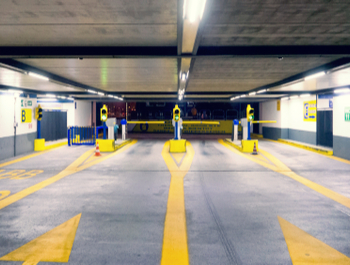Information
The Information Desks provide services such as directions, information and announcements, as well as explaining terminal layout and facilities. While direction service is provided to those passengers who approach the desks, information service is provided face to face or over the phone.
Information desks operate 24/7.
Useful Information

Shopping & Dining
See the full range of shops in our shopping universe. At the airport you'll find a great selection of shops within fashion, electronics, design and souvenirs

Parking
Your way to a secure parking space! Benefit from the attractive online parking offers of Gazipaşa-Alanya Airport

Flight Information
Real-time information of arrival and departure flights at Gazipaşa-Alanya Airport
Frequently Asked Questions
General Flight Information
Purchasing, canceling, or changing flight tickets are managed directly by the airline. Since each airline has its own rules, fees, and support channels (like websites, apps, or call centers), we recommend reaching out to them directly.
Operational processes such as departure, arrival, delays, cancellations, check-in, and boarding are under the control and responsibility of the airline companies and the ground handling agents that serve them. Therefore, for accurate and detailed information regarding such matters, we recommend contacting the relevant airline and ground handling service provider directly.
For domestic flights, it is recommended to arrive at the airport at least 2 hours before your scheduled departure time. For international flights, you should arrive at least 3 hours in advance. You can complete your check-in at the airport by visiting the check-in counters of your airline. Make sure to have your ticket, a valid ID (such as a national ID card, passport, or driver’s license), and any baggage you may need to check in. If you have already checked in online, you only need to go to the baggage drop-off counter.
To travel abroad with your pet, you must comply with both international regulations and the transportation policies of the airline. Since each airline and country may have different rules regarding pet transportation and entry requirements, it is essential to contact your airline in advance to ensure a smooth travel process.
Baggage Services
Your free baggage allowance may vary depending on whether your flight is domestic or international, your ticket class, and the policies of your airline. Therefore, for accurate information, you should contact the airline from which you purchased your ticket directly.
Processes such as baggage collection, transfer, transportation, and delivery are under the responsibility of the airline you are flying with and the ground handling company serving that airline. Therefore, in case of any issues such as lost, damaged, or undelivered baggage, you must contact the relevant airline or ground handling company before leaving the airport to ensure the matter is properly investigated.
Security Procedures
During security screening: Items like phones, belts, and coats must be placed in the X-ray machine. Laptops and electronic devices should be removed from their bags and screened separately. Sharp or flammable items are not allowed in cabin baggage and must be checked in. Follow the instructions of security staff and join the queue on time. Children are also subject to security screening, and their belongings will be scanned through the X-ray machine. For detailed information, please visit our website.
Liquids in hand luggage must: Be in containers of no more than 100 ml each. Be placed in a transparent, resealable plastic bag. The total volume of the bag must not exceed 1 liter, and each passenger may carry only one bag. Medications, baby food, and special dietary liquids may be exempt but must be declared at the security checkpoint. Liquids with an alcohol content over 70%, such as certain colognes or disinfectants, are strictly prohibited in both cabin and checked baggage under all circumstances.
Items such as sharp objects, weapons (including replicas), flammable or explosive materials, and toxic chemicals are not allowed in hand baggage. Liquids in hand luggage must be in containers of up to 100 ml, placed in a 1-liter transparent bag. For the full list and details, please visit the DHMİ Passenger Information page.
At our terminal, passengers who declare themselves as disabled or with special needs are provided Fast Track service together with one companion, without the need to present any documents.
No.
According to national and international aviation security regulations, medications and baby food required during travel may be carried in hand luggage. However, the following conditions must be met for these items to pass through security screening: Accepted Items: Medications: Must be listed on a prescription that includes the passenger’s name, or accompanied by a doctor’s report/medical certificate stating that the passenger needs to use the medication. Medications must be in their original packaging. Baby food: May be carried only in quantities needed for the duration of the journey, and only if the baby is also traveling on the flight. At the Security Checkpoint: - Security officers may ask you to present documentation proving the exceptional need. - If deemed necessary, they may also request that you taste the medication or baby food.
According to national and international aviation security regulations, liquid and paste-like items purchased from Duty Free stores or on board the aircraft are permitted through security checkpoints under the following conditions: - Items must be placed in a sealed, tamper-evident bag (STEB) provided by the store or airline. - The purchase receipt must be clearly visible inside the sealed bag. - The bag must remain unopened and undamaged until arrival at the final destination. These items are generally accepted on both direct and connecting flights. However: - If the passenger exits the secure area or transfers through another airport, the items may be subject to additional screening. - If the bag is opened or appears tampered with, the items may be confiscated at subsequent security checkpoints.
Customs Procedures
For detailed information on the exemption limits for personal belongings brought into Türkiye by passengers, please visit this page ((https://www.mfa.gov.tr/turkiye_ye-ait-gumruk-bilgileri.tr.mfa).
For detailed information about the cash limit you can carry when traveling abroad, please visit this page (https://ticaret.gov.tr/gumruk-muhafaza/sikca-sorulan-sorular).
Parking and Transportation
Yes, our parking areas offer a subscription system. For detailed information and current pricing, please visit our parking page. Please note that reservations are not available for our parking areas. Service is provided on a first-come, first-served basis.
Yes. Vehicles carrying a disabled person are exempt from parking fees for up to 15 days per entry. The vehicle must have the disabled person inside — having “Disabled Vehicle” written on the registration is not enough. For more information, please visit our parking page.
Our airport can be reached by HAVAŞ shuttle services, private vehicles, and taxis. For more detailed information, please visit our transportation page.
Passenger Services
Wheelchair service is available in our terminal. You can reach the information desk through the assistance totems located in front of the terminal. The information desk coordinates with the relevant ground services to ensure the request is carried out.
At the airport, you can enjoy 2 hours of free internet access by connecting to the ‘Gazipasa - Alanya_Belediyesi’ network. After connecting, you will be directed to a registration page where you need to sign up with your phone number including the Türkiye country code (+90). To complete the registration, enter the verification code sent to your phone via SMS in the designated field. Once verified, you can start using the internet service.
For details about the food & beverage places operating at Gazipaşa-Alanya Airport, please visit our website:
For details about the stores operating at Gazipaşa-Alanya Airport please visit our website.
Job and Internship Applications
For job/internship applications and information about application process, you can contact our Human Resources Department via email at gzphrisbasvuru@tav.aero
Passport and Visa Procedures
Regarding passport and visa procedures for arriving, departing, transit, or transfer passengers, we recommend contacting the Passport Police using the contact details provided below. You may also reach out to your airline for additional information related to your travel documents. Passport Police Contact Information: +90 242 552 71 26/27 Extensions: 1114
Transit Passengers
Transit/transfer passengers may benefit from other services available within the terminal depending on their flight schedule.
Lost Items in the Terminal
For items lost or forgotten within the terminal or parking areas, you may contact the TAV Terminal Operations/Information Desk, available 24/7 on weekdays and weekends. Phone: +90 242 582 71 26 / Extension: 4444-4381 E-mail: gzptim@tav.aero / cr@tav.aero For items lost during your flight, please contact the respective airline or their ground handling service provider.
Lost passports or ID cards found within the terminal or parking areas are handed over to the Airport Police Department. Therefore, you will need to contact the Airport Police directly for assistance. Phone: 90 242 582 71 26 Extensions: 1114
Items registered at the TAV Lost & Found Office are kept for a period of one year
Accommodation
No.